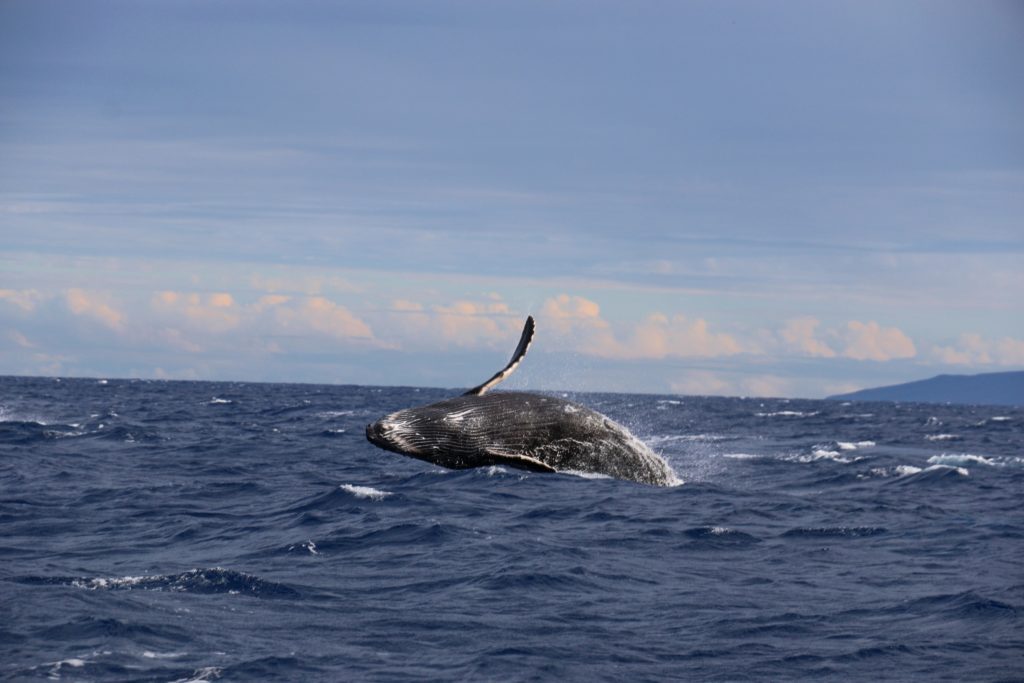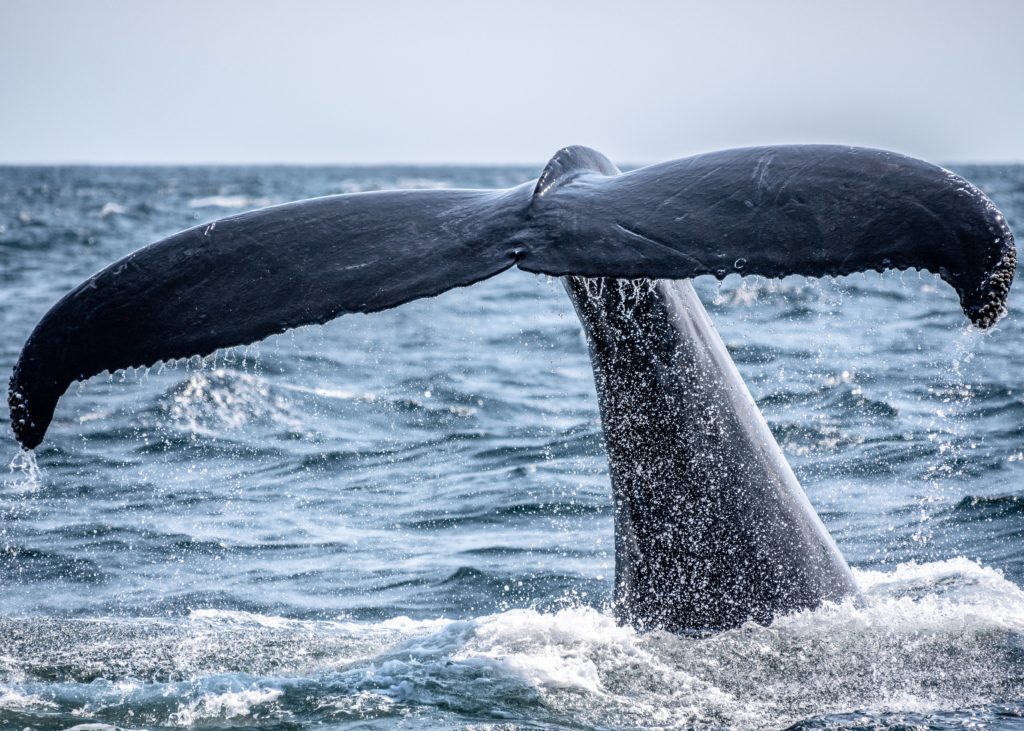Whale-watching is a popular activity, but when can you see whales in Hawaii? More importantly, where can you see whales in Hawaii? If you don’t go at the right time and place, you probably won’t see anything at all.
Here’s what you should know.
Which Whales Can You See in Hawaii?
The most common whales in Hawaii are humpback whales, with an estimated population of around ten thousand when they’re present in the waters. Humpback whales are seasonal in Hawaii, swimming down to mate in warmer waters and give birth before returning to Alaska.
Short-finned pilot whales also live in the area, with a population of almost nine thousand. These are closely related to dolphins and tend to show up in large groups, so you might see more than a dozen if you happen to catch sight of them.
False killer whales are rare in the area, with a population of roughly a hundred and fifty. Spotting them is relatively rare on most trips, though you may have some luck if you hang around their feeding grounds.
Melon-headed whales are more common than false killer whales in the area but more challenging to see in some ways. They often dive deep into the water and rarely surface over shallower areas, so you’ll need to sail a reasonable distance from the islands to have any chance of spotting them. Researchers believe almost 3000 live near Hawaii.
Sperm whales are scarce when it comes to sightings, although there may be more than seven thousand of them. There are usually just one or two confirmed sightings each year. Their close relatives, dwarf sperm whales, may number as many as 19,000 offshore.
Orcas rarely visit Hawaii, so the chance of seeing one is almost nonexistent. Researchers have noticed the occasional pod visiting, but this usually seems temporary, and they don’t seem to have a permanent or constant presence in the area.
Pygmy killer whales are rare worldwide but comparatively common around Hawaii, where there may be more than 800 living. Most of them don’t venture into the shallower waters near the island. They’re easy to confuse for the more popular melon-headed whales, so the odds of seeing them are low but realistic if you’re paying close attention.
Finally, there are several species of beaked whales in Hawaii. Like many of the other species, these tend to lurk offshore. However, around 15,000 of them may be in the area, so looking at the right time has a good chance of seeing one.

Where Can You See Whales in Hawaii?
You can see whales throughout most of Hawaii, but several places stand out as excellent choices.
Perhaps the best place for seeing humpback whales is by the Auau Channel, which runs between Maui, Molokai, and Lanai. This is a relatively shallow area that humpback whales like to visit for mating, and it’s quite easy to find tour boats when they’re around.
For Oahu, whales are the easiest to see along the southern coast. This faces the more comfortable waters barricaded slightly by the rest of the island chain, and there’s a national marine sanctuary on the southeastern corner of the island. The northern protrusion of Oahu is also an excellent place to see humpbacks.
Most other whales are more common on the southwestern side of the islands, or what people on Maui refer to as leeward. Whales are generally more common in deep waters, so you may have to travel quite a distance offshore to spot them.
Big Island is a surprisingly good place for seeing most whale species beyond humpbacks. Most of this has to do with the fact that it’s the bottom edge of the Hawaiian island chain, so whales who prefer deep waters have a much easier time swimming around it.
Knowing the Hawaiian islands is an important part of planning a trip. People who visit Hawaii often think they’re visiting Big Island when going to Oahu, easily the most populated island in the chain.
What’s the Best Way to See Whales in Hawaii?
The best way to see whales in Hawaii is by taking a guided tour to spots where they’re known to congregate. This is easy if you’re visiting during humpback season, where local tour operators keep close tabs on how the whales are moving around.
Various laws protect the whales in Hawaii, so expert tour operators can help you avoid accidentally running afoul of regulations designed to help protect the whales.
While the boats themselves can vary, tour guides can also help you row out in kayaks and get a closer view that way. Some people prefer this because kayaks disturb the area far less than motorized vehicles that could drive the whales away.
If you’re lucky, you could get mugged when you’re out watching. This is local slang for when whales come over to look at you in return.
Laws stop humans from getting too close, but the whales themselves have no such limits and can approach of their own accord. Be sure to pay close attention if this happens, as it’s challenging to experience on a whim.
When is the Best Time to See Whales in Hawaii?
So, when can you see whales in Hawaii? That depends on what you’re looking for.
The best time to see humpback whales is in January and February. The cold winter months drive their food away from polar regions, so humpbacks travel for several weeks down to the tropical areas to rest, feed, and mate.
The official watching season for humpbacks goes from mid-November to mid-May. While you might spot them at any point in this period, January and February are easily the best choices.
The first to arrive at the start of the year are usually mothers with their newest calves, followed by other children. The older males arrive after that, usually at the same time as females without young. The last to arrive in the year are pregnant females, who typically want to feed as much as possible before traveling.
Hawaii’s other whales are visible throughout the year since most of them live in the region full-time. As mentioned above, however, it can be hard to see them because they often swim in deeper waters and only come to the surface to breathe.
For context, many whales can spend at least an hour underwater, and sperm whales can usually reach 90 minutes.
They only surface briefly to breathe before diving back down to find food. Moving into shallow areas would force them to spend a lot less time feeding, which is why many whales don’t do that.
Some tour operators give snorkeling or even diving tours in areas where you might see whales.
It’s important to remember that tour operators cannot guarantee that you will see whales on your trip. Some boast at least 95% success, but that includes brief and distant glimpses rather than spotting numerous whales over long periods.
We cannot control the whales’ behavior, so remember that failure to see anything is possible.
That said, it’s almost guaranteed that you’ll see humpback whales during the peak season for it. There are so many in the area it’s almost harder to miss them.
So, when can you see whales in Hawaii? The honest answer is “anytime if you’re lucky”.

Top Tips for Whale Watching
Here are our top tips for going whale watching.
#1: Go At The Right Time
Some whales are seen more often at certain times than others. This is most obvious with humpback whales, who have almost no sightings at all outside their regular season, but even the other whales in the area tend to have yearly habits and preferences. Consider contacting tour guides to ask when specific species are most likely to be seen.
There’s also the time of day to consider. Whales still come to the surface to breathe when sleeping and may remain closer to it then. If the night is particularly bright and well-lit by stars, you might be able to see them breaching the water at that point.
#2: Have Good Gear
In this context, good gear usually means appropriate clothing for the season and viewing devices so you can get a better look. Many tour boats have binoculars already installed, but it’s better to bring your own.
Most ships in Hawaii can’t approach humpback whales any closer than 100 yards, though the distance can shrink if the whale decides to swim closer on its own.
This means that high-powered binoculars or handheld telescopes are better than low-powered ones that may not let you get a good image.
Adjustable binoculars and telescopes are particularly useful for looking around the ocean.
#3: Keep Your Camera Ready
Whales don’t stay at the surface for long, and many breaches only last a few seconds. However, because whales typically travel in pods, you may see several breaches on the surface in sequence. This means you need to be quick on the shutter if you want to get good pictures of whales.
It’s quite difficult to get good pictures of whales because you can’t chase them or encourage them to remain still for a photo.
If you want to bring a good photo back, be ready to take at least a few dozen pictures and discard any that don’t pass muster. This is far more realistic than trying to set up the perfect shot and take just one or two photos.
#4: Talk To Your Tour Crew
This only applies if you’re going on a guided tour instead of running your boat or kayak. Tour crews usually have years (if not decades) of experience in the area and are quite used to visitors asking for information. They can give you a lot of information on where to look, what to expect, and even which sorts of whales you end up seeing.
Make sure to follow the crew’s instructions to the letter. If they say you should or shouldn’t do something, there’s usually a reason for it, and failing to comply could result in fines or even arrest.
Fortunately, this rarely occurs unless whales get close to the boat.
#5: Be Patient
Whale watching is a lot like fishing in that you occasionally need to wait a long time before you get a good result. Many tours in Hawaii last about half a day, and it could be hours before you see whales.
The best mindset to have is going in with the understanding that nature moves on its schedule. You might see whales within minutes of leaving, or you might not see any the entire trip. That’s relatively rare, especially on professional tours, but it does happen.
#6: Choose Your Boat Carefully
Boats come in a huge variety of sizes and features. The smallest vessels are personal kayaks you might row out as part of a group, but larger ships may have toilets, bars, and even television sets.
There’s no right answer here because people prefer different things, but there are a few considerations to keep in mind when you’re deciding on a boat.
Bigger boats may have extra equipment like underwater cameras and hydrophones.
Hydrophones are special devices that can let you listen to sounds in the water, including whale calls. Underwater cameras are a nice alternative if whales are in the area but don’t want to breach the surface.
Some larger boats have glass bottoms or even transparent viewing chambers to get a much better view of the depths.
Smaller boats are usually slower and have fewer amenities. However, they also bring you much closer to water level, and people often prefer that in case whales get close. Small boats offer noticeably more personal experiences than bigger boats.
#7: Prepare For Sun
Hawaii is bright and sunny for most of the year. If you’re out on a whale-watching boat, that means you should use whale-friendly sunscreen or spend most of your time in shaded areas.
It’s easy to forget how much time you’re spending under the sun when you’re watching whales, but safety should always come first.
More about our TFVG Author
A seasoned traveller, Dad, and avid sports tourist, James foundered The Family Vacation Guide to share his expert vacation experiences- especially when it comes to being a travelling family man.
Featured in Travel articles such as Travel + Leisure, TripSavvy and SFGate, you know you're reading some of the best vacation tips online.





